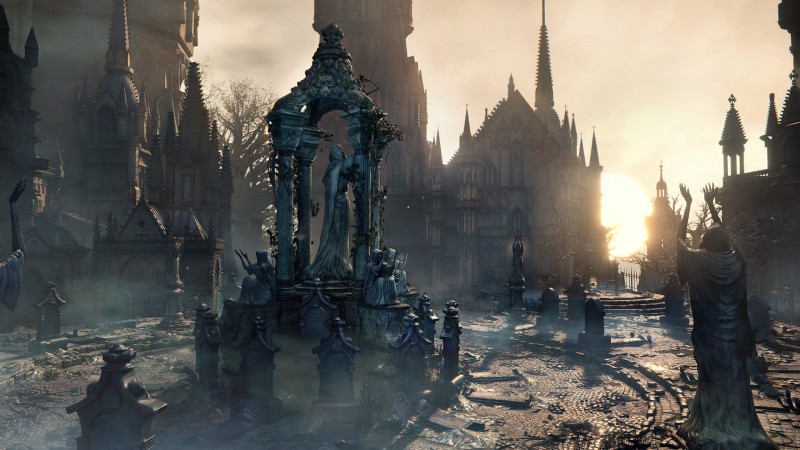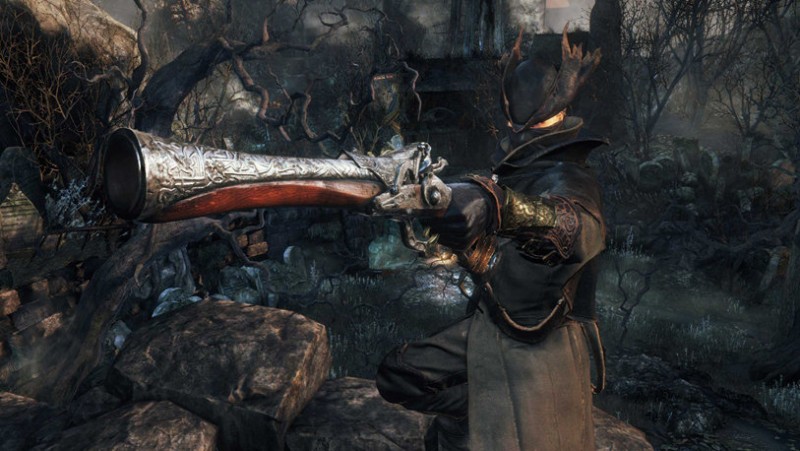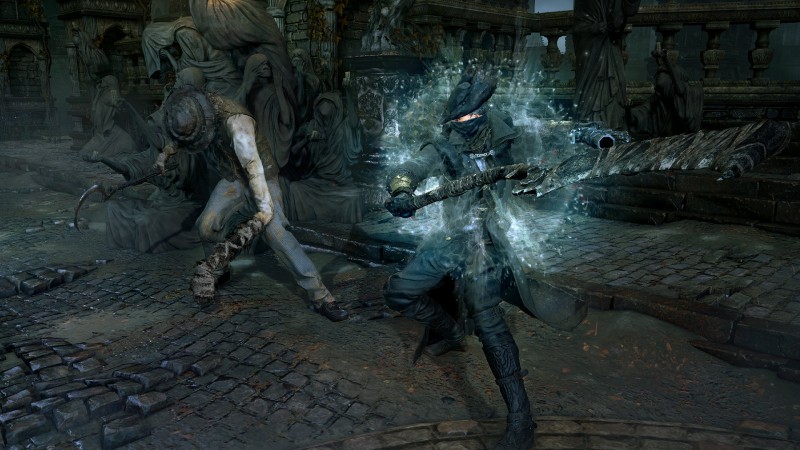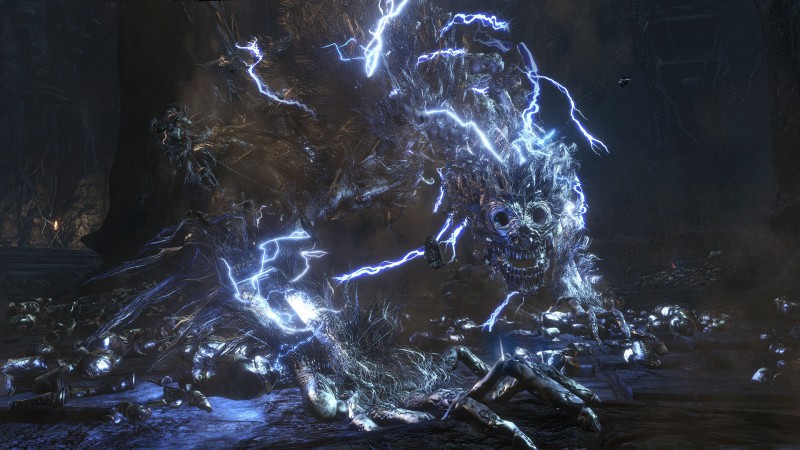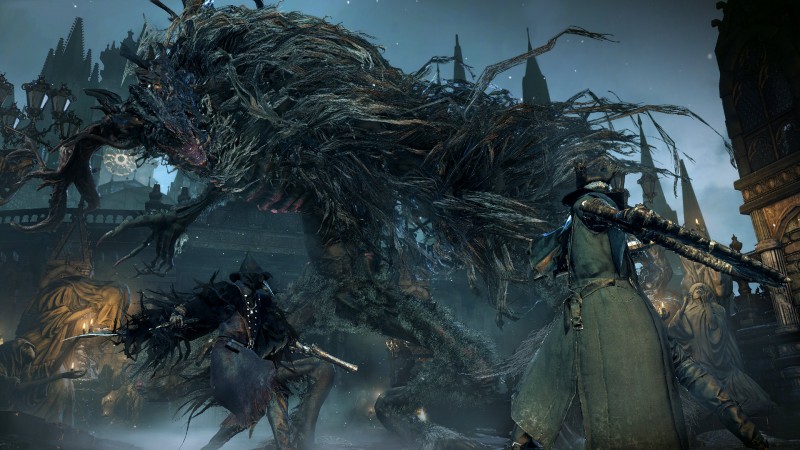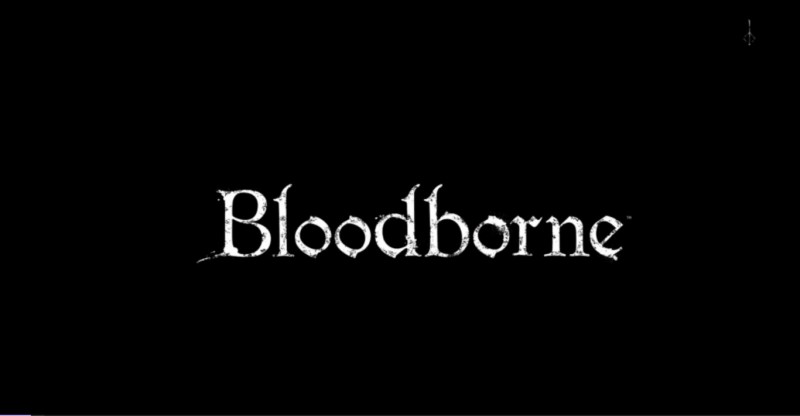There’s something to be said about a game that puts all of the control into your hands. Every mistake, slight calculation and eventual death are caused by you. On the other hand, every execution, slick maneuver and eventual success are also caused by you. The Souls series has always been known for these attributes that leaves the player’s fate up to them, and Bloodborne encompasses these feelings entirely. In fact, Bloodborne is a Souls game in every fashion besides the name. The feelings of dread and anguish, followed by the indescribable sensation of satisfaction upon achieving success, are all here in Bloodborne — in some ways better than it ever has been in the series.
Where the Souls games took place in gritty medieval times rich with fantastical settings, Bloodborne shakes things up by presenting a Victorian England world filled with Lovecraftian horror. The story in the Souls games has always been put on the backseat, left for impassioned players to piece together themselves. Bloodborne begins on the night of the hunt, with you springing to life from a blood manifestation to help rid the world of beasts. As you progress, the nature of this world slowly comes together as your character engages twisted creature after twisted creature. What exactly is happening in this world, and what is your part in it?
The setting is real here as gorgeous environments are — sometimes literally — dripping with character. As the initial city in Bloodborne, Yharnam is home to standard Victorian London streets, except in its own horrific way. Humans-turned-beasts are prowling the streets, murmuring that your character is cursed and swatting at you as you contemplate who the real beast is here. Off in the neighboring homes, laughter can be heard as people hide away, never risking to leave during the night of the hunt. Babies’ cries can be heard in the background as more questions arise as to what sick world are we really unwrapping here. While the Souls games were brilliant in their world building, Bloodborne takes it a step further in encompassing every feeling of horror possible.
The actual level design in Bloodborne is a huge part of what makes it such a treat to play. These worlds are meticulously created with distinct enemy placements to try to challenge you in every way possible. Items are constantly hidden and reward players who take their time to explore every inch. I think what makes Bloodborne so enjoyable is that it’s just flat out fun to explore, and the exploration is rewarded. Bonfires, or Lamps as they’re called in Bloodborne, are very far apart from each other, often not accessible until a boss is killed. To offset these long sections with no checkpoints, shortcuts are placed to help alleviate the struggle of getting through an area. When you’re low on Blood Vials and deep in a forest filled with deadly poisonous snakes, finding that shortcut back to a Lamp is one of the biggest feelings of relief you can get in a game.
As a veteran of the Souls series and a general gaming badass, I was ready to dive deep into this world and start slaying monsters with no problem. On the first night of playing Bloodborne, I was met with frustration and confusion as the combat system that I grew to learn had been revitalized. My shield was taken away from me and replaced with a gun. Enemies were far more aggressive, lunging and attacking at every opportunity. I was forced to learn all over again.
Quickly, I started to learn the ins and outs of the combat. While my shield was gone, my gun was perfect for stunning targets to go in for a visceral attack that dealt massive damage. The enemies may be more aggressive, but a new regain system is in place to allow me to match their power. Whenever you take damage, there is a small window of opportunity to move in and attack to regain some of that life back. Dodging rolls turn into short dashes to quicken the pace and keep the action up. Everything felt slightly faster than previous games in the Souls series, which felt like a smart direction to keep the series fresh. Once I became comfortable with the combat, as Breaking Bad‘s Walter White might have said, I realized that I wasn’t in danger but that rather I was the danger.
Bloodborne isn’t any different than the Souls games in that attacks are still very deliberate. Fumble an attack, and you’ll get punished; that’s how the combat has always worked. Sometimes, the punishment is a loss of a Blood Vial to regain some health, but for newer players, it might mean death more than anything. Killing enemies gives you Blood Echoes, which are currency collected to buy items and level up your character. If you die, your Blood Echoes can either be laid on the ground to be picked up or infused into a nearby enemy that you must kill to get them back. Die while you’re trying to get them back, and they’re gone. The mechanic may not be changed much from previous Souls games, but the system works so well at creating risk/reward situations that it didn’t need to be altered.
Where the combat takes a logical step forward, other parts of Bloodborne take a step back. Gone are the Estus Flasks from the Dark Souls games, which were healing resources refreshed at every Bonfire. In Bloodborne, the healing resources are called Blood Vials. Instead of constantly refreshing them at Lamps, they’re found as items dropped by enemies or bought from a merchant. It’s a bit of a mixture between Demon’s Souls and Dark Souls in that you can only carry 20 Blood Vials at a time, but they are still consumable resources. If you happen to get stuck on a boss, you’re forced to grind out enemies and Blood Echoes to get more Blood Vials. It’s puzzling why they went in this direction because the Estus Flask was such a smart design decision in Dark Souls. It removed the grinding found in Demon’s Souls and allowed for levels to be meticulously laid out so that the finite number of Flasks could get you through an area. While I never had a problem with running out of Blood Vials because I didn’t die that much, I could easily see how other players could get frustrated with the system.
The regain system is an excellent addition to help keep Blood Vial usage down, but there are points where it fails to be useful. About halfway through Bloodborne, enemies start getting exponentially more dangerous where damage from normal enemies can deal about half your health in one or two swipes. You can choose to go in to regain some of that health, but you greatly risk a quick and painful death. The better option is to just back off and pop a Blood Vial. These endgame sections don’t feel as intuitive to play given the quick combat to which you’ve become accustomed.
Where Dark Souls II failed in the creative boss design, Bloodborne picks up the pieces with some of the most memorable boss fights in the series. From a visual standpoint, director Hidetaka Miyazaki and his team have created awe-inducing creatures and monsters to fight. Wolf-like beasts and misshapen creatures 30 times your size loom over you as you dash in and out of their outrageous attacks to deal your own damage. Most impressive is how dynamic these fights are. Bashing a creature’s various appendages can affect how it reacts and flinches. A monster screams in agony and pain as it claws and slashes for retribution from a staggering gunshot, while bombastic music roars through the fight. It never felt like I was just hacking away at a life bar, but rather a real living thing with purpose in this twisted world.
At your disposal are a number of well-crafted weapons for hunting beasts. This time around, the number of weapons has reduced drastically from the hundreds in the previous Souls games. The difference is that each of these weapons in Bloodborne feels wholly unique in its design. Each weapon has two forms to use for varying situations. The Hunter Axe in its one-handed form is good for quicker, closer attacks. Hit the trigger button, and it suddenly becomes an elongated two-handed Halberd useful for wide, sweeping devastation. Each of these forms can be used in a combo with each other in a fight, which feels intuitive and empowering. Still, I missed how many different weapons that I could use and the various visual designs from the previous Souls games. Every Greatsword user is going to have the same Greatsword as everyone else in Bloodborne. The armor in Bloodborne also disappoints in a similar fashion because there just isn’t a whole lot of interesting armor. Many armor sets just feel like differing sets of cloaks and robes.
A large part of Bloodborne is its unique multiplayer aspect. At the base level, players can leave Notes on the ground anywhere in the world to help other players. You have to choose from a list of phrases and words like “beware” and “try,” followed by concepts or characters. I honestly couldn’t imagine Bloodborne without this system because it’s so helpful; at the same time, it doesn’t lessen the difficulty. Some people complain that Bloodborne is unfair with enemies jumping around corners that you may not have seen, but I never had that problem because of plenty of Notes informing me of immediate ambushes. In general, the Notes are smart because it brings the community together. We’re all in on this hellacious journey together, so why not help each other out with some Notes?
The other aspects of multiplayer gaming are either helping other players take down bosses in cooperation or invading their world to kill them for precious Blood Echoes and pride. In Bloodborne, Insight is used to summon other players into your world for help, which can be collected by defeating bosses. Ring a Bell, and another player who was ringing their Bell will soon come into your world to help trivialize a boss. Unfortunately, the already shaky frame rate can drop down to around 20 frames per second (FPS) when undergoing cooperative play. Aside from the frame rate issue, co-op works as well as it has in the past.
On the flip side, player-vs-player (PvP) mode has undergone a drastic change for the worst. In order to invade another person’s world to engage in a duel, that player’s world has to have a Bell Maiden in it. A Bell Maiden only shows up when a player has engaged in co-op or when they’re in one of two areas in the game. This means that you either deal with constant 1v2 fights or fight in a static location. The other problem is that the invader has about 30% less health than what they usually have, which gives them another disadvantage. Dark Souls II had damn near perfected the PvP system, which kept players constantly coming back months after release, so it’s incredibly disappointing to see Bloodborne take such a large step back. Along with the lack of weapon variety, it’s hard to see Bloodborne having the same lasting appeal as other Souls games.
Bloodborne tries to alleviate these longevity concerns with Chalice Dungeons. These are randomly generated Dungeons with multiple boss encounters and loot to discover. While a great idea in concept, the Chalice Dungeons are terribly boring in actual play. What makes Bloodborne so engaging is that the world is connected in a very precise fashion with shortcuts, and secrets abound. Because Chalice Dungeons are randomly generated, those important qualities are absent. The motifs and patterns of the Dungeons become very apparent very quickly. To add insult to injury, the loot you get from these Dungeons is laughably bad. More often than not, your rewards found in a Chalice Dungeon are materials to create another Dungeon. Supposedly, there are weapon variants and upgrade materials to find, but after going through five Dungeons, which take about an hour or more each to get through depending on the difficulty, I couldn’t bear to continue plodding through these boring Dungeons with little to no reward.
In terms of general performance, Bloodborne is just a mess. Going from playing Dark Souls II on my PC at 60 FPS to the 30 FPS of Bloodborne on PlayStation 4 was a bit jarring. On top of the lower frame rate, it actually dips below that 30 quite often when exploring certain areas. Thankfully, it was never a problem in combat, but it’s still disappointing considering that Bloodborne doesn’t exactly look leaps and bounds better than Dark Souls II.
The biggest offenders of them all are the loading times. When you die or warp to an area, it takes about 40 seconds to load. For newer players, I can imagine the already frustrating nature of dying often in the early game only to be mocked by extremely long loading times. This is further compounded by the fact that you can’t warp from Lamp to Lamp. Rather, you have to warp back to the main hub area called Hunter’s Dream, which takes 15 seconds, and then pick an area to reach via warp, which costs another 40 seconds. It makes absolutely no sense to go back to this system considering that it was made much faster and smoother in the Dark Souls games when you could warp from Bonfire to Bonfire. To put this in the best context possible, a speedrun of Bloodborne clocks in at around two hours, and of those two hours, 20 to 30 minutes of that time is spent in loading screens.
It’s always a bit difficult to review something like Bloodborne as a relatively hard-core Souls fan. It’s easy for me to get caught up in all of the minute changes with each new release in the series. Looking back critically at my time with Bloodborne, I can pinpoint the holes in the design like the backwards nature of the Blood Vial system and terrible PvP. At the same time, over my first 30-hour playthrough, it was an utterly captivating experience. I couldn’t stop playing.
I wanted to discover every unique world filled with horrific monsters and richly detailed environments that tell a story that I needed to piece together myself. I wanted to find that next boss and that next wonderful challenge to test my wit and will. After every session of Bloodborne, I was exhausted. Bloodborne requires your complete focus, and it tests your ability to adapt, think and learn to stay alive. The anguish of dying, the satisfaction of killing a monster that you thought you could never kill and the pride of understanding a level inside and out as you mercilessly kill enemies who gave you trouble before — these powerful feelings are constantly evoked in Bloodborne. These feelings are why I loved Bloodborne despite its flaws and why my time with Bloodborne will always be remembered as one of the best gaming experiences through which I’ve ever persevered.
Bloodborne is available for the PlayStation 4.

